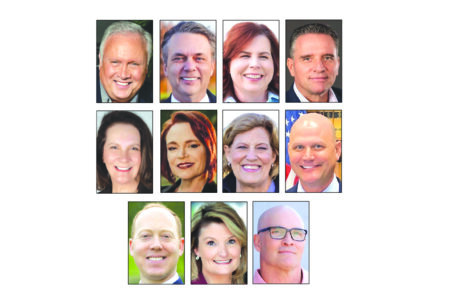KU to cut travel costs, reduce department budgets in effort to stave off projected $20M deficit in 2026
Layoffs won't be first option, but may be considered

photo by: Associated Press
A bus passes in front of Strong Hall, Monday, Nov. 16, 2015 on the University of Kansas campus in Lawrence. (AP Photo/Orlin Wagner)
Later this month, KU will end its 2025 fiscal year having nearly eliminated a $50 million budget deficit on its Lawrence campus.
There won’t be much time to party, though.
The university is projecting a more than $20 million deficit for the next fiscal year, as a new set of financial challenges have emerged.
“As expected, it worked and we got to where we needed to go,” University of Kansas Chancellor Douglas Girod said of a multiyear budget plan that saw an approximately $50 million general operating deficit shrink to a projected $800,000 in the current fiscal year, which ends on June 30. “But the world didn’t stop turning, unfortunately.”
Or, in the case of college athletics, shaking. KU officials expect the general operating budget of the university to take a $10 million hit next year as the result of a federal lawsuit settlement that will allow universities to directly pay their student-athletes.
As the Journal-World reported on Sunday, the settlement is expected to strain the finances of Kansas Athletics Inc.. The athletic department expects it will reduce the payments its sends to KU’s general operating fund to reimburse the university for expenses like tuition, lodging, utilities, maintenance and more. A KU spokeswoman on Monday confirmed the reductions are projected to total $10 million in the upcoming fiscal year.
But if all works as planned, KU student athletes won’t be the only ones seeing larger paychecks. KU leaders are budgeting an increase of at least $17 million in its general operating budget to improve the pay of select employees who are making less than similar positions in the private sector in the region.

photo by: Chad Lawhorn/Journal-World
University of Kansas Chancellor Douglas Girod is pictured on Nov. 7, 2023.
For several years, Girod and other KU leaders have said KU is at risk of an employee crisis because of the number of positions that make significantly less than similar positions in the private sector or at research universities across the country. While KU, has recognized the issue, it hasn’t traditionally budgeted to solve it. This is the first time KU has included the sizable “market pay” adjustments in its financial projections.
“We’ve got to get to pay, and pay is built in here,” KU Chief Financial Officer Jeff DeWitt said of the pay plan.
But the pay plan will come with a cost that likely will include budget reductions in other parts of the university, and could include the elimination of some jobs. When you combine all the new expenses of the 2026 budget, plus factor in some new revenues — enrollment is expected to grow and tuition rates are scheduled to rise — KU’s general operating budget is projected to have a $22.3 million deficit in the fiscal year that begins July 1. By fiscal year 2029, the deficit is projected to rise to nearly $40 million.
Those numbers, however, are if KU doesn’t make other adjustments to the budget.
“We are not going to do nothing,” DeWitt said in a video message about the 2026 budget. “I don’t want anybody reporting out that we are in a tailspin here. That is if we do nothing, and there are actions we are going to take.”
Some of those actions will begin in a matter of days. Beginning July 1, university departments will be expected to cut their travel budgets by 20%. KU expects to achieve another 5% in budget cuts by making targeted expense reductions in various departments. Those cuts haven’t yet been announced.
By Jan. 1, KU intends to implement another round of budget adjustments totaling $10 million in the remainder of 2026 and $20 million in future years . KU is hopeful that some of that $10 million comes from new revenues. A new KU convention/conference center at the university’s renovated football stadium is expected to open before the end of the year, for example. The university also is aggressively promoting its new online learning program, Jayhawk Global, that has new classes beginning all the time and are offered to students both nationally and internationally.
But some of the $10 million of adjustments likely will come from reduced expenses. DeWitt said a reduction in the number of employees at the Lawrence campus could be one result of the budget plan.
In a follow up statement, KU spokeswoman Erinn Barcomb-Peterson told the Journal-World that headcount reductions could come through attrition, which is when the university doesn’t fill a position after someone voluntarily vacates it. When directly asked, however, Barcomb-Peterson didn’t rule out that some layoffs could occur at the university.
“We would look to avoid layoffs by reducing workforce through methods such as attrition and/or voluntary separation programs before we considered layoffs,” Barcomb-Peterson said via email. “Additionally, if headcount reductions are needed, they would be done strategically in a way that limits the impact on our core mission of education, service and research.”
In addition to a reduction in the number of employees, the university also will look to save money by centralizing more of its purchases and even partnering with other universities on some needs, according to the presentation. A review of “administrative and academic program efficiency” is also expected to be undertaken. That review will focus on eliminating “redundant and unnecessary services,” and also will look to “identify opportunities for automation,” Barcomb-Peterson said in a follow-up response.
The budget forecast has a couple of big caveats. First, KU is in negotiations with labor unions about new contracts. Last year, faculty members at KU voted by a large margin to form a union to negotiate with administrators for better pay, benefits and working conditions. In his presentation, DeWitt said all of the employee pay matters would be subject to negotiation with the university’s unions.
But a bigger unknown may come from Washington, D.C.. The Trump Administration is proposing that federal research universities face greater limits on how they can use federal research grants to pay for operating expenses, such as utility bills for laboratories, equipment purchases, and salaries of various administrators who oversee research functions.
The new limitations have been challenged in court, and their implementation is uncertain. As such, KU hasn’t factored that possibility into the 2026 operating budget. Rather, KU is assuming that the KU Center for Research could absorb a roughly $10 million cut in the federal funding at the Lawrence campus — but it could only do so for one year.
KU leaders are concerned changes in federal policy could have an impact far and above the $10 million that KU’s research enterprises could absorb.
“By far, the most significant risk and challenge to KU’s financial health is the unpredictability of federal research support and other federal actions impacting higher education,” Barcomb-Peterson said.
In his message to the university, Girod said the challenges from the federal level highlight the need for KU to come up with new revenue streams, whether that be from its convention and conference business, online education or other initiatives that haven’t yet been developed.
“The reality is, higher education is at a crossroads, and universities must develop new financial models for the new world we are in,” Girod said. “Universities that do this proactively will have the luxury of developing thoughtful strategies that have the best chance of success.”







